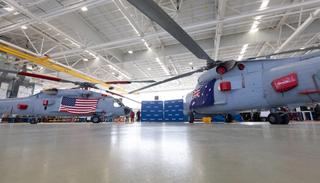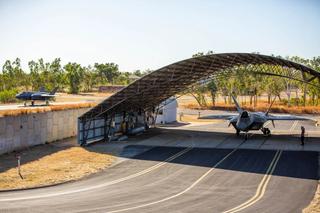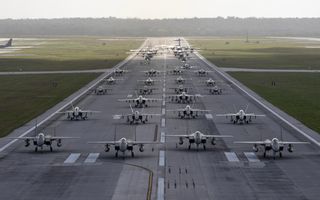Executive summary
- A new security architecture has emerged in the Indo-Pacific, driven by the challenges posed by China’s growing power and malign behaviour, and efforts by other regional powers to build up their own independent and collective military capabilities.
- The regional security environment is increasingly characterised by a latticework of overlapping security relationships, as many regional powers move from being passive security consumers to active security providers. Crucially, these countries are willing to work both with and without the United States in the pursuit of regional stability.
- Many US allies, including Australia, have pursued advanced military capabilities, greater defence industrial base integration, and improved posture enhancements independently and in groups, all of which help to enhance deterrence by denial and improve the resiliency of the regional security order.
- Though the United States no longer enjoys outright primacy in this increasingly multipolar regional security architecture, these trends nevertheless help to advance US interests by shoring up a favourable regional balance of power and bolstering collective deterrence vis-a-vis China.
The era of US unipolarity in Asia is over. China’s rapid military and nuclear modernisation, economic power, and revisionist tendencies have narrowed the window for Beijing to tip the local balance of power in East Asia. Even if China cannot yet command the same kind of power and influence as the United States at the global level, it is well on the path to doing so. Russia, though presently weakened because it invaded Ukraine, remains a nuclear power. More than one major power exists, resulting in a more multipolar system — globally and regionally.
The United States finds itself in an unprecedented position of needing to deter large-scale conventional aggression from these two major powers while simultaneously managing persistent threats such as North Korea, Iran, and violent extremist organisations around the globe. This challenge comes at a time when the United States lacks the requisite capacity, capability and readiness to meet this challenge and fulfil its extended deterrence commitments. These shortcomings have spurred efforts to reorganise the US military for great power competition and conflict, particularly with China.1
This paper argues that the end of US unipolarity has led to a new regional security architecture in the Indo-Pacific, but this architecture is not incongruous with US interests and objectives as set out in the 2022 National Defense Strategy.
Preparing for great power competition and conflict has led the Biden administration to emphasise working with allies and partners to help make up for shortfalls in national power and to better deter common threats, particularly in the Indo-Pacific.2 While America has doubled down on its alliances and partnerships, these nations have also reacted to shifts in the regional balance of power and increasing multipolarity. In the Indo-Pacific, states have responded to the twin developments of China’s rise and changes in US military strategy by seeking greater agency in the security domain, modernising their alliances with Washington and buttressing their own military capabilities. In so doing, they have altered regional security architecture — but not necessarily in a way that is disadvantageous to US interests.
This paper argues that the end of US unipolarity has led to a new regional security architecture in the Indo-Pacific, but this architecture is not incongruous with US interests and objectives as set out in the 2022 National Defense Strategy. China’s actions have galvanised like-minded allies and partners’ determination to build independent capabilities and act both with and without the United States. Insecurity has led states to externally balance by deepening security partnerships amongst themselves and reinforcing collective deterrence and defence. This overlapping network of security relationships has enabled improved capability development, defence industrial base integration, and posture enhancements that aim to enhance the strategy of deterrence by denial among the US and its allies and partners and to improve the resilience of the prevailing security architecture in the Indo-Pacific.
A new security architecture in the Indo-Pacific
The shift towards a more multipolar order in the Indo-Pacific is, in large part, the result of China’s rise and coercive actions altering the threat perceptions and responses of its neighbours. Several US allies and partners have attempted to move from being passive security consumers to being active security producers. Most notably, Australia and Japan have adapted their national defence strategies in light of these perceived threats, assuming much more proactive approaches to developing their military power.3 Measures that these countries are pursuing include developing independent military capabilities, building out their indigenous defence industries and strengthening regional alliance networks, with the United States often as the primary, but not always as the dominant, partner.
The desire for independent military capabilities is driven by a need to improve regional states’ abilities to both defend themselves and to contribute to a strategy of collective defence while offering the flexibility to act autonomously.
The desire for independent military capabilities is driven by a need to improve regional states’ abilities to both defend themselves and to contribute to a strategy of collective defence while offering the flexibility to act autonomously. This has taken the form of efforts to acquire high-end weaponry or build domestic defence production. Australia’s pursuit of nuclear-powered submarines and Japan’s decision to acquire long-range strike capabilities stand out as examples of high-end capability development and acquisition.4 South Korea’s continued development of its indigenous defence industry to become a significant arms exporter is another form of increased military independence.5
This push for greater agency amongst America’s allies coexists with a preference for building collective security.6 This is evidenced in greater cooperation among regional states, a shift from long-held preferences to work bilaterally with the United States. Examples include Japan and South Korea’s rapprochement, the reciprocal defence arrangements between Australia and Japan, and the growing defence relationship between Japan and the Philippines. It also includes the rise of minilateral groups such as AUKUS.7 While many of these minilaterals include the United States, the structure is differentiated from previous regional security groups as Washington no longer acts as the central hub for cooperation. Together, these initiatives are intended to improve nations’ military capabilities and networks with the aim of strengthening collective deterrence against Chinese coercion. The Indo-Pacific is therefore seeing both a shift toward independent capabilities and a reinforcement of collective deterrence and defence.

Though the modality of security relationships has changed, the United States continues to play a sizable role in formal and informal groupings and remains an anchor in the regional security architecture. As regional states have sought to become active security producers, they have deepened defence integration with Washington. Though the security environment is changing, there is still a desire—if not a need—among regional nations to work with the United States. Concurrently, there is a growing recognition in Washington that the United States needs its allies and partners in the region more than ever before. This mutual dependence has put the United States and its regional allies on a more equal footing and moved the regional architecture further away from the traditional hub-and-spoke arrangement.
Though the modality of security relationships has changed, the United States continues to play a sizable role in formal and informal groupings and remains an anchor in the regional security architecture.
The rise of more independently capable powers and patterns of security minilateralism in Asia should not be viewed as a hedging strategy or a shift away from the United States. Rather, it should be understood as an effort by regional powers to modernise their US alliances for a new regional environment, including by moving toward a greater level of burden-sharing that Washington has long desired. The regional architecture has moved farther away from the hub-and-spoke arrangements and closer to what some have referred to as “latticework” security arrangements, whereby minilateral groups are layered over traditional bilateral and multilateral relationships.8 A networked security architecture of overlapping bi-, mini-, and multilateral groupings, both formal and informal, is not incongruous with US preferences or deterring China from aggression. Rather, it helps actualise the integrated deterrence concept found in the current US defence strategy and adds credibility to collective deterrent threats.
US deterrence logic
The 2022 National Defense Strategy (NDS) is centred around the “cornerstone” concept of integrated deterrence. Integrated deterrence seeks to integrate all tools of national power across domains, geography and spectrum of conflict.9 Most notably, integrated deterrence stresses allies and partners as the “centre of gravity” for this strategy.10 The strategy recognises that the United States lacks the resources, force structure and capabilities needed to deter the “pacing challenge” of China and the “acute threat” posed by Russia, while also managing other global threats.11 From Washington’s perspective, capable allies and partners are needed as force multipliers in terms of combat power and materiel, and to lend additional credibility to deterrent threats in the form of combined resolve. This has elevated the importance of incorporating allies and partners into US deterrence planning and activities, particularly in the Indo-Pacific.12
Embedded within the strategy are three deterrence logics: deterrence by denial, deterrence by resilience, and deterrence by direct and collective cost imposition. Though each logic has distinct implications for US allies and partners, the NDS links deterrence by denial and deterrence by resilience most closely. Deterrence by denial aims to make an adversary believe that it cannot attain its military objectives at an acceptable cost,13 which in turn requires combat credible forces able to defeat aggression where and if it occurs.14 For forces to be combat credible, they must be postured and outfitted to be ready and able to respond to aggression, and resilient enough to fight through an attack to defeat an adversary.15 Thus, deterrence by denial is linked to resilience.
For integrated deterrence to succeed in the Indo-Pacific, the United States needs to bolster both deterrence by denial and resilience by working with allies and partners.
Deterrence by resilience, as articulated in the NDS, means that the United States and its allies and partners must be able to withstand and fight through adversary attacks on key nodes and infrastructure, recover quickly and resume operations.16 In the Indo-Pacific, this extends beyond an immediate attack or short-term conflict, given that a conflict between the United States and China would likely become protracted. As the Ukraine war has demonstrated, the ability to maintain and sustain US and allied forces will also be essential in a protracted conflict.17 The capacity of the US and allies’ defence industrial bases and related supply chains to support the continued employment and sustainment of these forces is a core part of deterrence by resilience.
For integrated deterrence to succeed in the Indo-Pacific, the United States needs to bolster both deterrence by denial and resilience by working with allies and partners. Encouragingly, there are significant efforts underway to strengthen collective deterrence by denial and resilience in the Indo-Pacific in three core areas: capability development, defence industrial base integration, and posture enhancements. An examination of these efforts demonstrates that different overlapping groupings have made sizable progress, thereby improving deterrence in the region.
Capability development
A notable shift has occurred in the aspiration of US allies to invest in key capabilities that would be essential in a potential conflict with China.18 Australia’s aim to build nuclear-powered submarines under the AUKUS arrangement and Japan’s pursuit of long-range strike capabilities are two foremost examples.19 These decisions not only reflect a recognition of China’s growing military power but also a desire to actively contribute to deterring and, if needed, defeating Chinese aggression collectively with the United States and, ideally, with other regional countries. These capability developments therefore go beyond the defence of just Australia and Japan and extend to wider regional defence, as they could fulfill critical warfighting missions expected in a potential coalition conflict with China.20 These capability enhancements also reflect a greater level of integration with the United States than ever before, moving beyond national defence to actively contribute to US warfighting efforts. This integration has in turn emphasised the need for greater allied involvement in US military planning to capitalise on these capabilities, improve interoperability, and develop critical warfighting skills.21 As US allies such as Australia, Japan, South Korea, and the Philippines are demonstrating their willingness to operate with each other—a positive sign for future coalition operations—more needs to be done to harness these multilateral groupings to create the effective building blocks of deterrence.22
A notable shift has occurred in the aspiration of US allies to invest in key capabilities that would be essential in a potential conflict with China.
Regional cooperation with the United States and among allies further extends to the co-development of new capabilities relevant to deterrence and high-intensity warfare. The AUKUS SSN is perhaps the most obvious example, particularly as it is driving efforts to overcome barriers to greater defence industrial integration, such as the US International Traffic in Arms Regulations (ITAR).23 Other efforts are burgeoning, such as the announced US-Australia-Japan trilateral cooperation on uncrewed aerial systems, which may open the door for Australian and Japanese involvement in the US Air Force’s collaborative combat aircraft program or the US Department of Defense’s Replicator initiative.24 AUKUS Pillar 2 may also provide greater opportunity for trilateral co-development of advanced technologies. It may also move beyond trilateral cooperation, as there is discussion of Japan and South Korean involvement in Pillar 2.25 This reflects the dynamic that security relationships are increasingly becoming a two-way street: not only are countries seeking to obtain US military technology, but they are also looking to produce it or, in some cases, contribute advanced technology and capabilities of their own to collective efforts. There are other co-development efforts underway that do not involve the United States but integrate Indo-Pacific and European allies and partners, such as the Japan-Italy-UK development of a next-generation fighter.26 Though this effort may reflect dissatisfaction with obstacles to industrial cooperation with the United States, such diversification should not be viewed negatively as it further cements the relationship between two of America’s closest allies—Japan and the UK—and creates linkages between European and Indo-Pacific security.27
Defence industrial base integration
Related to capability development are efforts to build greater defence industrial base (DIB) capacity and resiliency in the Indo-Pacific. The US DIB is currently strained as it seeks to equip Ukraine in its fight against Russia, provide material support to Israel and Taiwan, replenish what has been drawn down from US stocks, and fulfil Foreign Military Sales requests from Indo-Pacific partners—all while also producing the capabilities required by the US military to prepare for potential future conflicts.28 Despite lingering export controls and domestic measures such as ‘Buy America’ provisions for certain defence articles, the reality is that the required capacity cannot be readily found without leveraging and integrating allied and partner DIB capacity.29 Greater allied DIB integration would not only improve US industrial capacity but would also create greater collective resilience in two key ways. First, it would create redundancy in production capacity by increasing the number of outputs for priority items, enhancing the ability of the United States and its allies and partners to withstand supply chain shocks and to meet surges in demand. Second, it would allow for greater breadth in the production of capabilities and components rather than optimising for a specific set of capabilities, which hedges against risk and produces more resilient supply chains.

Efforts to build a networked DIB in the Indo-Pacific are nascent at best, but there are signs of where such integration could occur.30 Munitions should be a priority area, given global demands.31 The United States, having already significantly drawn down its stores, has relied on South Korea to help provide needed 155mm artillery for Ukraine.32 South Korea’s defence industry has stood up additional production lines to improve the production capacity of 155mm rounds, while Australia has similarly invested in boosting 155mm production with US technological assistance.33 Moreover, the agreement for US-Australia cooperation to produce long-range missiles in Australia demonstrates how a networked DIB in the Indo-Pacific would not over-optimise by producing one type of munition and instead produce a greater range of munitions, from short- to long-range munitions, which may be needed for different contingencies.34 Greater industrial collaboration on munitions and relevant energetics with South Korea, Australia, Japan, and others may be an area of future DIB integration.
Posture enhancements
The other area where the United States is leveraging overlapping security arrangements to improve deterrence and resilience is in its posture enhancements. US warfighting concepts are currently predicated on dispersal, or shifting forces to alternate locations to improve their resiliency and survivability. Access is a necessary pre-requisite to execute distributed operations in the Indo-Pacific, which requires a network of ‘far’ bases—outside of Chinese missile range—and ’near’ bases.35 The United States has sought to improve its posture in the region to enhance force survivability and the ability of theatre forces to contribute to deterrence, and has made significant headway with additional access in Japan, Australia, and the Philippines.36 The development of the Enhanced Defence Cooperation Agreement sites in the Philippines, coupled with the development of a Combined Logistics, Sustainment and Maintenance Enterprise (CoLSME) in Australia, will provide greater options for geographic distribution and further improve US force resiliency.
The United States has sought to improve its posture in the region to enhance force survivability and the ability of theatre forces to contribute to deterrence, and has made significant headway with additional access in Japan, Australia, and the Philippines.
Distributed operations require more than shifting forces; they also require equipment to operate from these locations. In addition to gaining more base access, the United States has sought to enter into cooperative agreements with host nations to pre-position equipment and stockpile critical supplies, including fuel, munitions, and medical supplies.37 Such stockpiles are intended to facilitate dispersal operations but also sustain forces and operations — a critical element of resiliency. Moreover, initial steps have been taken to prepare maintenance and sustainment efforts in the Indo-Pacific. For example, the US Navy is considering how it can leverage commercial shipyards in Japan and India for enhanced maintenance, repair, overhaul, and upgrade facilities to improve readiness. Such efforts could extend to other countries in the Indo-Pacific, such as Singapore, South Korea, and the Philippines.38
Posture agreements between like-minded US allies in the region also hold promise to strengthening deterrence as they enable joint operations and speed of response, and would improve collective force resilience. The reciprocal access agreements between Australia and Japan, and Japan and the Philippines, for example, further strengthen regional efforts to build a networked posture among allies willing to actively contribute to deterrence and defence efforts.39 As such, these arrangements help to improve deterrence and the integration of US allies with one another adds additional credibility to collective deterrent threats.
Conclusion
A new phase of defence cooperation in the Indo-Pacific is underway, reflective of an increasingly multipolar security order driven by responses to the critical challenge to regional security posed by China. These trends only highlight the importance of collective efforts to deter changes to the status quo by force — and the inability of a single country to do it alone. This is the crux of the US concept of integrated deterrence. But a byproduct of the United States needing allies and partners more than ever is that the once uneven playing field between America and its allies has begun to level, creating more equal and mutually reinforcing relationships between Washington and its key defence partners. As a result, collective security in the Indo-Pacific is increasingly democratised and networked. Leveraged properly, this could create greater resiliency for like-minded security partners, as states will not rely on any one security relationship, but rather several relationships that sometimes bisect, overlap, and interact in support of shared deterrent aims.

Though the realities of what is needed to deter China both now and in the future are well understood by regional states, more needs to be done to actualise the level of integration required for successful collective deterrence efforts and to build resiliency over the long term. Creating processes that enable greater integration are required—particularly when it comes to military capability development and defence industrial base cooperation. More so, greater emphasis on collective planning is desperately required to capitalise on recent gains in capability development and force posture, and to account for the greater agency of increasingly capable allies and partners. Improving strategic and operational planning between the United States and its most capable allies is the sorely needed missing link in a networked security architecture.40 Understanding how, where, and by whom such capabilities could be employed for collective deterrence and defence and how coalition forces would be sustained is imperative, and would better align independent capabilities and actions to create a coherent collective deterrence strategy.






